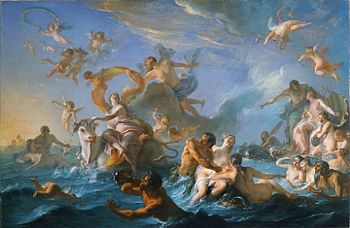Noël-Nicolas Coypel
hideThis article has multiple issues. Please help or discuss these issues on the talk page. (Learn how and when to remove these template messages)
|

L'enlèvement d'Europe ("The Abduction of Europa"), 1726–1727.
Noël-Nicolas Coypel (17 November 1690 – 14 December 1734) was a popular French artist.
The son of Noël Coypel and half-brother to the more-famous painter Antoine Coypel, he was accredited to the Academie Royale in 1716. He was appointed a professorship in 1733, but died shortly thereafter in a domestic accident.
References[]
- Jérôme Delaplanche, Noël-Nicolas Coypel (1690-1734), Arthena, Paris, 2004.
- This article incorporates text from a publication now in the public domain: Chisholm, Hugh, ed. (1911). "Coypel". Encyclopædia Britannica. 7 (11th ed.). Cambridge University Press. p. 355.
See also[]
- A bust of Noel-Nicolas Coypel, c. 1729, by Jean-Baptiste Lemoyne.
Categories:
- 1690 births
- 1734 deaths
- 18th-century French painters
- French male painters
- Accidental deaths in France
- French painter, 17th-century birth stubs